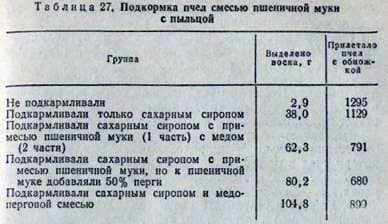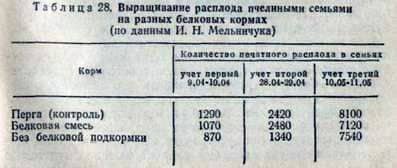
For a long time already beekeepers noticed that in the absence of pollen in nature, bees willingly collect and carry flour in beehives (in the form of patches), visiting mills, barns, warehouses and other premises. Seeing this, beekeepers began to put flour in the apiary in sheltered shelters, but feeding bees to flour gives negative results, since they do not digest its nutrients. The fact that the bees collected flour in the apiary are explained by a “mistake of instinct.” With a lack of nature pollen, bees collect not only flour, but also other absolutely useless substances, such as grated bricks, dust, soot, etc.
To compare the nutritional value of various substances, families were formed from young bees, who were placed in large greenhouses. The bees were given the tested food and the amount of brood was grown (Table 26), the construction of honeycombs, the mortality of bees and the increase in protein in their body.

From the data obtained, it was concluded that dry yeast can replace pollen by 50%, milk by 20%, etc.
Perga (pollen) in all experiments far surpassed all the tested forage.
In these experiments, bees were fed exclusively with food tested with sugar. However, it can be assumed that when feeding flour, bees lacked vitamins, abundant in pollen. Proceeding from this at the Ukrainian experimental station of beekeeping, an experience was set up for feeding bees with flour with a different admixture of pollen.
From young age-old bees formed 10 families of 0.5 kg each. The bees were given a 50% solution of sugar and white wheat flour, finely ground, mixed in various proportions with Perga. The experiment was conducted in the autumn, when bees could bring only a very small amount of pollen to the hive from the field (Table 27).

Feeding bees with wheat flour while simultaneously collecting pollen significantly increased the allocation of wax. The lack of vitamins and other substances in flour is compensated by the abundance of them in the pollen. A repeated experiment on feeding bees of toasted wheat flour together with Perga, carried out at the Institute of Apiculture, showed an increase in the amount of protein in the body of bees and the number of larvae grown.
Bees are more willing to take toasted wheat and oat flour both in pure form, and in a mixture with honey. To explain the reason for this, experiments that allowed using the iodine-starch reaction to follow the decomposition of starch grains contained in flour and pollen in all parts of the intestine of the bee helped to explain the cause. It was found that large starch grains passed through the intestines of the bee without change, while starch grains of small size decomposed in the midgut. The same picture was observed with large starch grains inside the pollen grains: they passed the intestines of the bee without decomposition. Apparently, the thick shell (amylopectinic) surrounding the large starch grains is so strong that the digestive juices of the bee can not pass through it.
Toasting the flour leads to the destruction of the shells of starch grains, they crack, partially decompose, and then the contents of the starch grains become available for the digestive enzymes of the bee, and this increases the nutritional value of the flour. Bees digest soy flour, which contains small starch grains. Manufacture it in factories, where soybean seeds are crushed, roasted and extracted by pressing.
For better use by bees of defatted soya flour, it is mixed with pollen (rejuvenated), obtained by means of pollen collectors, in the proportion of: 75% of the flour, 25% of the pollen. The mixture is kneaded on a sugar syrup to a thick dough-like mass and in the form of cakes are given to bees.
When used for top-dressing bees of cotton flour, it is also mixed with pollen. On 70% of flour, 30% of pollen is added. The mixture in dry form is poured into empty cells of honeycomb and filled with sugar syrup (per 1 liter of water 1 kg of sugar). Then the honeycomb is left for a day, during which time the flour is moistened with sugar syrup, and in this form the honeycombs are inserted into the nests.
Thus, flour in its pure form can not replace pollen. But the flour of skimmed soy and cotton in a mixture with pollen can be assimilated by bees and promotes the growth of larvae and the release of wax.
To exhibit flour in the apiary in the spring period in the absence of pollen in nature is useful. This reduces the loss of bees in the field in the search for pollen and makes it possible to partially compensate for the lack of perga in the hives.
The beekeeper, as a result of his thirty years of research, came to the conclusion that the best results are given by the following composition of feed: three parts of soybean fat-free flour, one part of dry skimmed milk and one part of dry beer or baker’s yeast. All this is thoroughly mixed and ground. If the amount of brood, obtained by feeding pollen, is taken as 100%, then, by eating only this mixture, the bees grow 65% of the brood. If you use the above components for bee feeding separately, soy flour gives 76.6% of the brood, yeast – 67.3, dry milk – 36.6% of the amount obtained with the use of a mixture of these substances. Experiments on the longevity of bees in cages showed that when feeding pollen the bees lived 47.4 days, yeast or soy flour 38.0, pure sugar 22.5 days.
Dry pollen collected from plants, dried and ground refined, as well as an artificial protein mixture, both in pure form and in a mixture with dry pollen, can be given to bees outside the hives. The mixture is poured into the feeding troughs – flat boxes with a plywood bottom and side edges 4-6 cm high. These feeders are placed at a distance of 10-12 m from the apiary in sunny, sheltered places from the wind. On large apiaries set several feeders in different directions from the apiary and protect them from the rain with awnings.
On the bottom of the box-trough put pebbles or wooden brusochki such a size that they protrude a little from the layer of powdered powder; bees will sit on them, and this will make it easier for them to create an update. The layer should not be thicker than 15 mm. To quickly attract bees to the feeders, near them or in their place in the early days put honeycomb with liquid sugar syrup or honey.
The bees take pollen and its substitutes and put them in honeycombs near the brood, which is very important for feeding young bees feeding the brood. With the advent of pollen in nature, bees stop visiting feeders.
To make bees more willing to take a feed mixture, they can first be taught to her. To do this, mix the mixture with a spatula into the cells of the honeycomb near the brood. By releasing these cells, the nurse-bees get used to the smell and taste of the food and then they take it more readily from the streets above the frames.
On the fodder mixture, bees grow brood even in the complete absence of pollen and perga. Especially effective is the feed mixture in early spring, when there is usually a strong lack of pollen in both hives and in nature. The feed mixture in the recommended composition contains all the substances required for brood rearing. Dry milk gives a full set of substances necessary for growth of larvae, and yeast provides the necessary composition of vitamins.
The test at the Institute of Beekeeping of this protein mixture gave positive results. Three identical groups of bee colonies were selected, 10 families each. These families were supplied with honey and protein food of different composition for the winter. The first group of families gave 2 honeycombs with fresh perga, II – in the same amount the protein mixture, and the third group of protein feed was not given.
Families who ate protein mix, at the first accounting only on 17% have lagged behind the control families which have received a feather (Table 28).

On the second account, they raised as much brood as the family with Perga. Families who did not have protein forage were severely behind. Only later, when all the families of bees began to bring pollen from the field, the number of brood in them increased.
In another experiment, two equal groups of bee colonies were formed in spring (April 4), 10 families each. At the same time, the first group of families was not given additional protein food, and they were satisfied only with the reserves of last year’s perga in the nests and the pollen introduced by the bees on the summer days; The second group of families was additionally given a protein mixture, which was dumped dry into honeycomb cells and filled with sugar syrup. In this experiment, families receiving protein supplementation in combs, in 35 days, raised brood by 15.2% more and had bees by the end of the experiment by 400 g more.
The soy-milk-yeast mixture is undoubtedly assimilated and well used by bees, but they eat it willingly only in the absence of pollen and perga. To ensure that this protein supplement has attractive taste for bees, you should add 15-20% of pollen to it.
Определение пади. Щавелевая кислота в пчеловодстве.
Feeding base of beekeeping